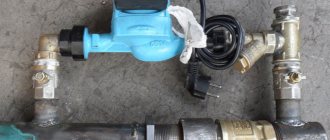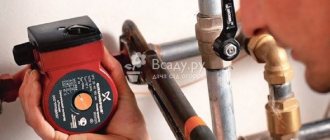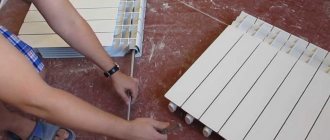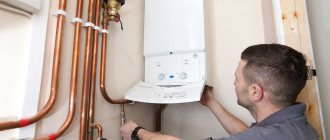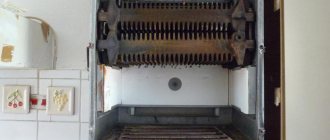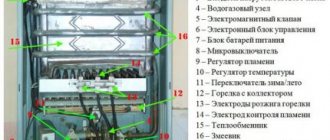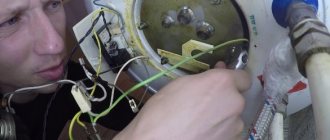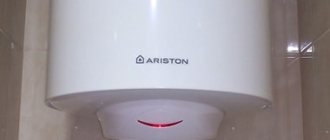Centrifugal pumps: design features in heating systems

These pumps are integrated into the indoor heating circuit in order to increase its efficiency. When it is turned on together with the operation of the boiler, the temperature in the living rooms rises almost instantly. In addition, convective heat transfer from heating devices improves, since with forced circulation, there are practically no stagnant zones in the network, and the coolant evenly washes all heating surfaces.
The pressure created by the centrifugal device is sufficient for the liquid medium to successfully overcome all existing hydraulic resistances in the network: valves, mud collectors, air vents, batteries, bends and branches and rise to its highest point. For two-story households and above, the installation of a circulation pump in the heat supply system is mandatory. A competently executed installation of the unit reduces the cost of generating thermal energy by up to 20% due to the organization of efficient heat exchange.
An electric pump for circulation of heating water is produced in a housing in which working units and electrical elements are mounted. The main working link of the structure, which rotates the impeller, is the rotor located inside the stator winding.
The housing for such units is made of durable corrosion-resistant materials:
- Aluminum alloys;
- cast iron body, with a pulley;
- stainless steel;
- double or multicomponent brass alloy.
whether the circulation device should be heated, the reasons, what to do if it heats up


Incorrect operation of the circulation pump leads to various problems, including overheating.
Due to overheating, the pumping equipment may fail, which will lead to the shutdown of the entire heating system. This is especially dangerous during the winter.
Odnoklassniki
Should the pump in the heating system of the house be warmed up?
The purpose of installing such a device is to pump fluids in the heating system and create pressure. These processes help to heat the heating device, but not critical.
The temperature of the circulation unit and pipes should be approximately the same... If the deviation is large, then this is already overheating of the device.
Why the circulation pump is heated: the main reasons and methods for their elimination
There are several options for situations indicating a malfunction of such a device.
Incorrect installation
If the position of the rotor is incorrectly determined and its axis is displaced from the horizontal, there is the likelihood of an airborne effect. As a rule, it will be possible to find out about such an erroneous installation of the device immediately after the start of operation of the heating system.
To solve this problem need to correct the position of the rotor.


Photo 1. Scheme of installation of a circulation pump in the heating system. To install it, you will need a lot of components.
The device heats up due to a clogged system
The process of circulation of the coolant through the pipes is fraught with the formation of rust in them and the accumulation of deposits. As a result, the pipes are narrowed, and pumping equipment has to increase its own load to push the liquid. This is how it overheats. Clearing the heating structure will resolve this situation.
Reference. Helps solution with caustic soda, which fill the heating system
ogon.guru
The principle of operation of network centrifugal pumps


After the power is supplied to the device, the rotor begins to rotate, and with it the impeller, located with it on the same shaft.According to the principle of centrifugal force generated by the impeller, water is drawn from the suction pipe.
At the outlet of the impeller, the coolant enters a spiral-shaped channel in the form of a confuser, in which the kinetic energy received by the liquid from the impeller is transformed into potential energy, thereby increasing the pressure in the heating network.
Features of the design of the circulation pump
The pump body is made of materials that are durable and resistant to corrosion processes, usually:
- aluminum;
- cast iron;
- steel;
- brass.
After the engine is started, the rotor begins to rotate in the pump, which is equipped with an impeller. After that, the pressure at the inlet pipe decreases, as a result of which the liquid is sucked into the hydraulic chamber. Due to the rotation of the impeller, centrifugal force is generated.
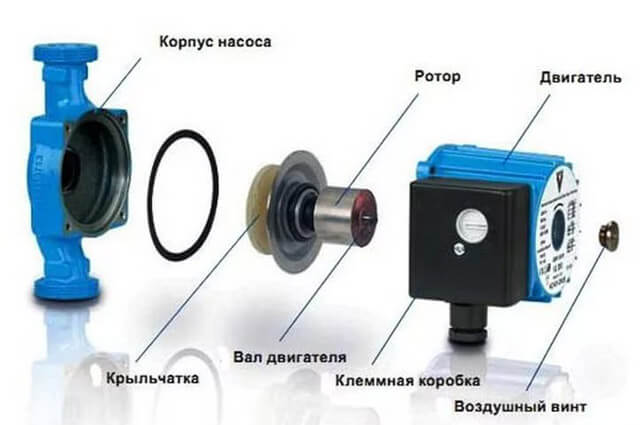

The liquid medium is pressed against the walls of the chamber and thrown out through the outlet into the pipeline. This is the forced circulation of the heat carrier in a closed heating circuit.
Structural differences in the structure of the rotors of a centrifugal pump for heating
For indoor heat supply systems, two types of devices are used - with a "wet" or "dry" rotor. In the first, it is separated from the pumped liquid by special sealing glands in the form of rings, between which there is a thinnest coolant film. During wear, the sealing parts wear out and at the same time are compressed even more tightly, which guarantees an additional tightness of the block that can withstand the load for a number of years.
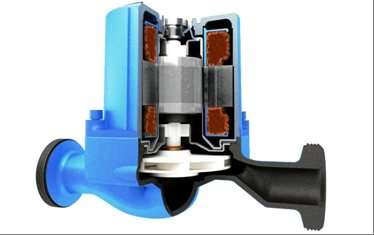

In order for this to be so, such devices require constant maintenance. In the process of pumping liquid, suspended solids that are present in the coolant get between the seal rings, thereby violating the tightness of the entire structure.
The disadvantage of these centrifugal-type devices is their increased noise. Therefore, they are not suitable for indoor use. Due to the fact that they have the highest efficiency and consume less electricity for their own needs, units with a "dry" rotor are more often installed at high thermal heating loads, in a separate building of a boiler house or heat point.
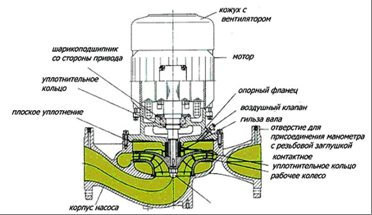

For devices operating with a "wet" modification, the impeller with the rotor is placed in a liquid medium, they are washed by a hot coolant. Electrical assemblies with a starter are housed in a sealed steel glass. During the operation of such a device, the coolant serves as a cooling and lubricating medium for the rubbing parts of the unit, therefore it works almost silently and, therefore, they are preferable for installation in individual houses next to the boiler. Such devices are not whimsical to maintain. And despite the fact that they have low productivity and low efficiency of no more than 50%, these units are more popular with the owners of small cottages. The lifespan of the device depends on the manufacturer of the equipment and usually ranges from 5 to 10 years.
Why it is heated: the main reasons and methods for their elimination
There are several reasons why heating occurs. All of them indicate problems in work.
Incorrect installation
If the location of the power unit is incorrectly determined, with a subsequent horizontal displacement, the effect of filling with gases appears. A characteristic feature is the appearance of weak rustling sounds. If they appear after the start of use, you can immediately recognize it. To fix the problem, it is enough to correct the pump location. When working, you will need to use a building or laser level and a plumb line to clarify the fastening.
Heats up due to clogged system
When the coolant moves through the pipeline, the natural result is the formation of rust and other deposits that clog the duct. For this reason, narrowing of the pipes is observed. Devices with automatic control will then accelerate to achieve the same speed. When the load on the power unit increases significantly, as a result of which heating occurs. To solve the problem, you will have to clean the pipeline.
Foreign body
Metal debris, corrosive particles that have broken off from the internal surfaces of the batteries can clog the power unit for forced circulation, which leads to blockage of the system. The object enters the primary or secondary part of the transformer windings, causing them to deteriorate.
In this case, it is required to carry out unscheduled preventive measures regarding the pump operation system, which will help get rid of foreign debris and unnecessary elements. If the pump components are damaged, you will have to replace or hire a specialist for repair.
Lack of bearing lubrication
If there is an insufficient amount of lubricants in the design of ceramic bearings at some point, then the elements wear out. Because of this, scratching noises may occur during operation, and the rotor may jam. For repairs, you will have to replace the bearing, apply lubricant or hire specialists.
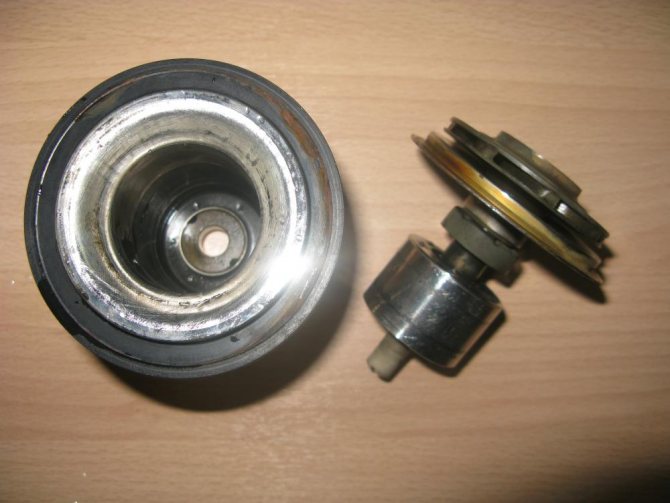

Replacing the bearing
Undervoltage in the network
According to the state standard, the voltage in the network must be 230 volts. At lower values, the rotor receives less energy from the power source and airing of the pump is observed with subsequent damage to the equipment. To prevent this, you must first measure the voltage in the network. This can be done with a voltmeter or multimeter.
Insufficient head
Overheating causes incorrect power connections. If the paddle wheel is connected to a three-phase network. In this case, the shaft rotates in the opposite direction. An increase in the viscosity of the coolant leads to a decrease in the pressure. During operation, rotating blades must overcome increased resistance, which affects the energy expended during operation and, as a result, heating.
To get rid of this type of problem, you will have to check the cross-sectional diameter of the pipes, then correctly adjust the pump operation. If an inlet filter with tube is present, clean it.
Stop after start
The problem arises if from a three-phase network the wires are incorrectly connected to the terminals of the unit. The reason is a fuse that is not tightly protected. To fix the defect, you need to clean the contacts, after which you need to carry out the correct connection.


Structural elements
Heating circulation pump selection parameters
Before choosing such a pump, it is necessary to consider a number of important parameters:
- Productivity is the volume of pumped water per unit of time. This size is determined by the manufacturer of the boiler, since it will depend on how much water will pass through the heating source and the rate of cooling of its internal heating surfaces.
- The maximum permissible temperature of the pumped medium is also a significant indicator, which is indicated in the pump's data sheet, and must correspond to the limiting temperature of the water that the boiler can produce.
- The diameter of the inlet / outlet branch pipes must match the diameter of the boiler piping.
- Head - this characteristic shows to what height the network water can be raised. Usually, for single-storey buildings, an indicator of up to 20 meters of water column is sufficient, and for multi-storey buildings 60 meters of water column.This indicator should be much higher than the highest mark of the house, since a significant part of the pressure is lost on hydraulic resistances in the network.
- Power is the limiting electrical indicator consumed by the pump for its own needs.
- Availability of safety automatics - ensures device shutdown in case of an emergency in the system.
Circulation pump installation procedure
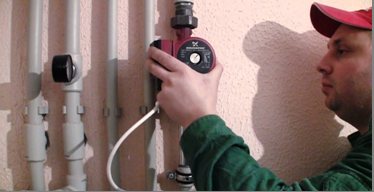

Before connecting the unit, you need to choose the right place for placement. It must be remembered that the device requires periodic maintenance, and therefore there should be enough free space near it. The most optimal area for placing the device is in front of the boiler. Such a scheme will prevent the formation of air congestion.
Additional advantages of this option are that the unit will operate with a low-temperature coolant, which will significantly increase its service life. An equally important point in the installation of a centrifugal unit is the location of the working shaft. It must be remembered that the shaft must be placed exactly in a horizontal position. Otherwise, it will not be able to be completely immersed in a liquid medium, which will cause a significant loss of productivity and will contribute to the rapid decommissioning of its working units.
Overheating of the pump casing: the main causes and options for their elimination
In case of detecting a hot body, the consumer must immediately stop the fuel supply to the boiler and stop the electric pump. In order to be able to further cool the internal heating surfaces of the boiler, the bypass or bypass line of the heating network is opened so that the coolant circulates through natural circulation and thereby cools the boiler. Next, the user should try to establish the reasons why the circulation pump of the heating system is heated.
Heating of the pump structural units can occur for the following reasons:
- The installation of the device was carried out in violation of the technology determined by the equipment manufacturer.
- Clogged piping system. Deposits of hardness salts and rust in the inner surface. During many years of operation, they sometimes reach such dimensions that they are able to completely cover the flow area of the pipes. This is especially true in areas with poor circulation. In order to push water through the clogged section, the pump is overloaded, this mode causes the electric motor to overheat.
- The ingress of a foreign body, a similar reason for heating the housing, only the pump is clogged with foreign debris and slag inside.
- Bearings are not lubricated. This failure is typical for dry units.
- Poor quality parameters in the network, less than 220 V.
- Internal causes of electrical failure.
Why pumping equipment is heated
If the pump heats up in the heating system, this drawback must be eliminated. The temperature of this device should be similar to that in pipes filled with a coolant. When it is higher, then problems arose during operation or errors were made during the installation process.
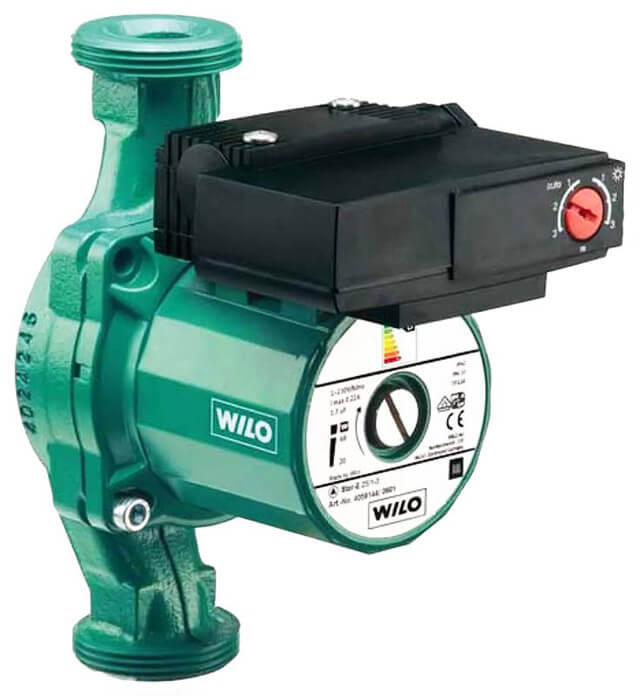

The water pump heats up for a number of reasons:
- Incorrect installation... It is not difficult to find out that mistakes were made during installation - the device begins to overheat at the beginning of the operation of the heat supply structure.
- Clogged system... Over time, deposits and rust build up in the pipes, resulting in a narrower opening for the fluid to pass through. To push water into narrowed pipes, the pump is forced to operate under increased load. As a result, the electric motor overheats. To eliminate the deficiency, unscheduled maintenance of the system elements should be performed.
- Foreign body ingress... Since pipes and batteries are slagged, pieces of plaque and rust are chipped off from their inner surfaces.Once in the pump, they jam the motor. If the device is not cleaned in time, the engine coils will fail.
- Insufficiently lubricated bearings... Since there is not enough lubricant, they wear out much faster, and as a result, the operating time of the device is reduced. In order not to burn out the heating pump, it must be dismantled and sent for repair.
- Undervoltage in the network... When it is less than 220 V, the engine overheats and soon fails. As soon as the first signs of overheating appear, you need to measure the voltage in the network with a voltmeter.
If the heating pump heats up, you should not immediately dismantle it, since the reasons for this are different. First, you need to measure the voltage in the network and, if the values are normal, then rinse the system with caustic soda, filling it with a solution for at least one hour.
When this does not help, you need to contact a specialist, because the pump in the boiler is heating up and may burn out and you will have to buy a new device, since rewinding the motor windings is very expensive.
How to disassemble the circulation pump
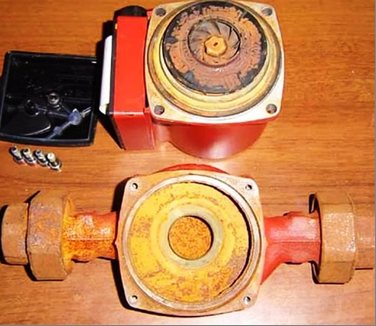

To repair a centrifugal pump installed in the heating circuit, you will need to dismantle it, adhering to the following scheme:
- The electrical part of the apparatus is disconnected from the voltage; for this, the case is removed from the power supply unit.
- Close the valves in the supply and return pipelines or before and after the device, if possible.
- Carry out drainage of the network water so that when the housing is removed from the pipeline, it is not flooded with water.
- In order to unscrew the case, use a hex screwdriver. If the bolts boil during operation, then they are treated with a special WD tool and after 20 minutes, the dismantling operation is repeated.
- After disassembly is complete, remove the cover, under which the rotor with the impeller is located. Usually, it is attached with stoppers or bolts. After that, the passage to the internal structural units of the unit will be opened.
- Having carefully inspected the technical condition of the pump, it will be possible to identify defects and eliminate them.
How circulating pumps work and work
The principle of operation of circulation pumps is not much different from the device of drainage models. The body of the device is made of durable materials that are resistant to corrosion. Usually it is stainless steel, aluminum, brass, cast iron. When started, the engine starts to rotate a rotor equipped with an impeller. As a result, the pressure at the inlet pipe decreases and water is sucked into the hydraulic chamber. The rotation of the impeller creates centrifugal force. Water is pressed against the walls of the chamber and is forcibly thrown into the pipeline through the outlet. This ensures forced circulation of the coolant in a closed heating circuit.
Design differences between devices of different types
There are two main types of pumps - wet and dry rotor. The "wet" rotor is separated from the water by special sealing rings, between which there is a thin water film. When worn, the rings are abraded and pressed more tightly against each other, which guarantees the tightness of the structure for several years. Cooling and lubrication is carried out by the working fluid. Pumping equipment of this type is installed in systems that are small in terms of the volume of the coolant, because it is difficult to ensure tightness of joints in structures of large diameter. When installing devices, it is important to achieve a strictly horizontal position of the shaft, otherwise the device may malfunction.
The main advantage of dry models is their high efficiency. It is 80%, which compares favorably with the 50% efficiency of devices of the "wet" type. Rotors of "dry" heating circulation pumps do not come into contact with liquid. Depending on the location of the engine, structures are divided into horizontal (cantilever), vertical and block structures.All "dry" models make noise during operation, are sensitive to the quality of the coolant and the purity of the air. It is advisable to install them in separate rooms of the boiler rooms, controlling the purity of the water in the system and the air in the room.
Replacing the mains pump repair kit
Most major manufacturers sell ready-made repair kits for the repair of centrifugal units. For example, such a set for a network pump u4814 pumping up 5200 l / h and operating with a voltage of 12/24 V costs 950 rubles. Purchasing a similar kit significantly reduces repair costs. It is possible to carry out repair work on the pump on its own only after the end of the warranty period or the absence of service centers in the area of residence.
Stages of pump repair with the installation of a repair kit:
- Disassemble the pumping part of the device;
- carry out troubleshooting of the internal components of the unit;
- replace rejected parts;
- assembling the unit;
- installed in the workplace and perform post-repair service and performance check.
Heating pump repair video
In the case when the circulation pump of the heating system is heated, you should not immediately disassemble it, for the reason that breakdowns are different. First, you need to measure the voltage in the mains and, if the parameters are normal, then it is necessary to flush the internal circuit of the network. For this, a caustic soda solution is introduced into the circuit for 1 hour. After that, you need to flush the pipelines with clean water. If scale was the cause of the stop, it will go away and the pump should start working. If this action did not bring any results, and the boiler is under warranty, then it is better to contact the service center.
